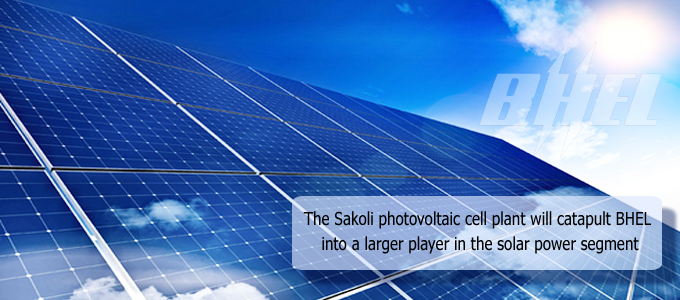|
Public sector undertaking BHEL, is expanding its limited presence in the solar power equipment industry by setting up a solar photovoltaic cell manufacturing plant at Sakoli, in Bhandara district of Maharashtra. Coming up at an investment of Rs 2,731 crore, the project is BHEL’s largest investment in the power plant equipment manufacturing segment.
Maharashtra government, while clearing the project, granted it the “Mega Project” status and extended all special incentives that go with the status. MIDC has already secured 480 acre for the plant.

BHEL intends to execute the project in two phases. In the first phase, the power equipment giant will be setting up a fabrication plant with an investment of Rs 500 crore. And the solar cell plant will be set up in the second phase. The state government has assured special status to both the phases.
Manufacturing solar power equipment is not a new venture to BHEL. The company presently manufactures apparatus for solar lanterns, photovoltaic cells, water heating systems etc, at its Bangalore plant. The Sakoli plant will catapult BHEL into a larger player in this segment. Apart from manufacturing photovoltaic cells, modules and solar panels, the plant will also manufacture solar wafers. Solar or silicon wafers are key components of solar photovoltaic cells. The wafers are currently imported as they are not domestically manufactured. As BHEL’s initiative will result in import substitution, the company will also be entitled to avail subsidies under the National Clean Energy Fund (NCEF).
BHEL will use indigenous technology to make the wafers cut from crystalline silicon ingots. This will help reduce the cost of photovoltaic cells and eventually the cost of setting up solar power projects. At present, the cost of putting up solar power projects is pegged at around Rs 8-10 crore per megawatt. Thus, the new facility, along with the 4,000 MW ultra mega solar power project in Rajasthan, will help BHEL in commanding a substantial segment of the growing solar energy market in India. .
At present, solar energy capacity at 2,600 MW accounts for a miniscule per cent of the total installed power capacity of 245.39 GW in India. However, the growing appetite for setting up solar power plants by Indian companies is expected to increase the demand for solar equipment in the coming years. At present, there are about 322 solar power projects worth Rs 45,489 crore in various stages of implementation. This nascent industry is also being aided by a series of offerings from the government, like financial concessions including subsidies, excise duties and sales tax exemptions as well as the relaxation of not needing any licences under the Industries (Development and Regulations) Act.
The Indian solar power sector is besieged with a couple of key issues which are hurting the fast growth of the sector:
|
|
-
The high cost of photovoltaic cells, the core of the solar energy system, results in high project cost.
-
Most of the projects presently in the pipeline are small in size. The industry is looking for some high ticket projects to spur the domestic solar equipment manufacturers. BHEL’s entry is a welcome step in this direction.
-
The domestic equipment manufacturers are presently facing stiff competition from dumping of equipment from countries like China, Chinese Taipei, Malaysia and USA.
|
The newly formed NDA government has taken the right step in bringing non-conventional energy under the fold of the power ministry. India has set a target of adding 20,000 MW in solar power by 2022, under the Jawaharlal Nehru National Solar Mission (JNNSM). And, in order to achieve this target, we need to have a strong base of domestic solar power equipment manufacturers. While a blanket ban on imports of equipment is not the ideal solution, the ministry has to find a solution to the dumping issue so that local producers will get a level playing field to compete and strive in the growing solar equipment market.
|